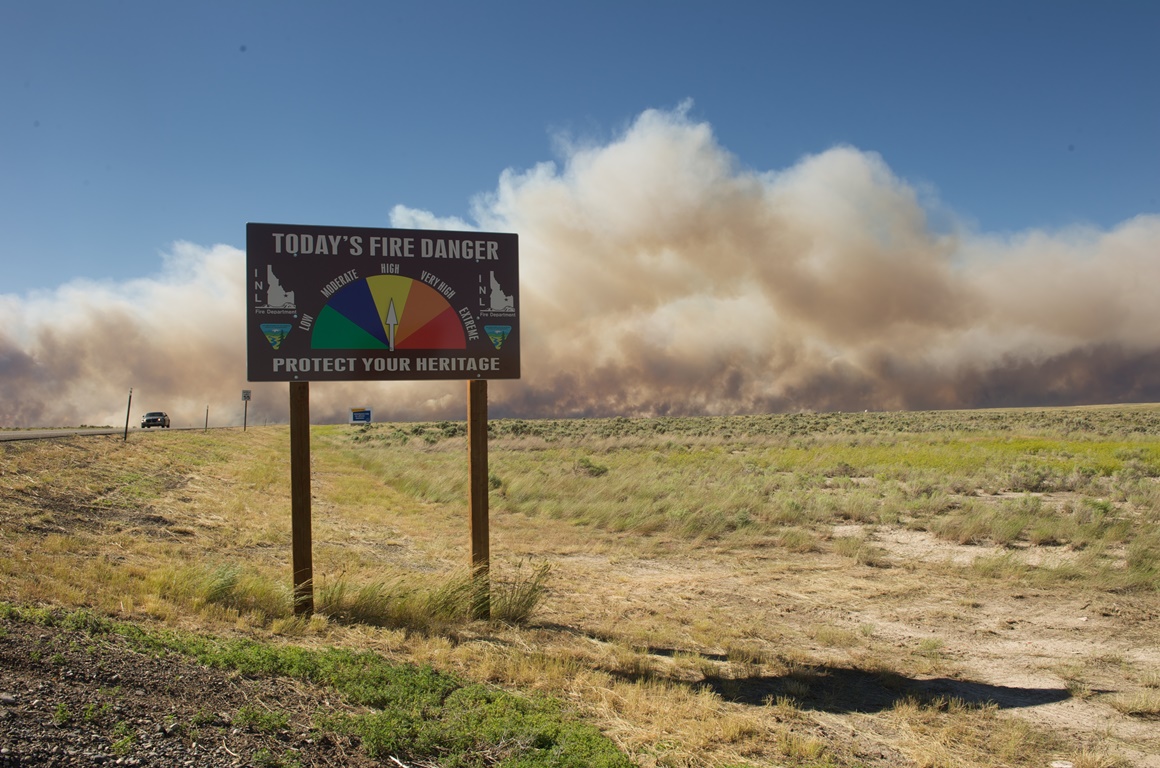Preparations for INL’s 2017 fire season underway
IDAHO FALLS — The Fire Department at the U.S. Department of Energy’s Idaho National Laboratory is preparing for the 2017 wildland fire season. Every spring, the fire department reviews its fire preparation procedures and lessons learned from previous fires. By doing this, firefighters are better prepared to protect people, property and the environment at the desert Site from future wildland fires.
Fire danger normally increases as the grasses and sagebrush dry during the summer on INL’s 890 square miles of high desert land west of Idaho Falls.
This summer also brings an additional concern associated with the total solar eclipse on Aug. 21, which is during Idaho and INL’s peak wildfire season. This event is expected to draw up to 300,000 extra visitors to the region. The influx into fire-prone wildlands has the potential to result in more accidental fire starts while making it harder for fire and emergency response organizations to respond.
“INL experienced above-average precipitation over the winter and spring months, which has resulted in significant growth of grassy fuels,” said INL Deputy Fire Chief Jim Blair. “These fuels are green now, but by the end of June, they will cure, and we can anticipate a significant fire potential. By late July and into August the sage brush, juniper and grasses at the Site will be fully cured, thus supporting the potential for large fire development.”
INL’s skilled and well-trained fire department and emergency response organization have demonstrated the ability to effectively respond to the large, wind-driven fires that occur on the desert.
Since 1994, the INL Site has averaged six fires a year and a seasonal total fire acreage of more than 13,000 acres. Throughout this period, the INL Site experienced no significant facility damage.
“It has been a few years since the last large wildland fires, so there is a lot of fuel and very few fuel breaks. We have defensible spaces around major buildings and facilities, and INL and State employees are currently mowing roadways on and surrounding the Site to battle the potential for roadside fire starts. Fortunately, our firefighters and support personnel are well equipped and prepared to rapidly attack any new fire,” Blair said.
“I am very confident in the capabilities of our personnel,” INL Fire Chief Eric Gosswiller said. “We view each fire as a learning opportunity to further improve our response tactics while ensuring firefighter safety. We’ve also focused on improving our coordination with BLM and other agencies that assist INL in these large fires.”
There are three fire stations located at the INL Site, each with wildland firefighting equipment.
“At this point, we are prepared for the season and expect fire potential to increase dramatically in the coming weeks. This year, meteorologists are expecting more storms to move across the region. This can be good or bad. We are hoping for the moisture, but if the storms bring dry lightning, we may have a busy year,” Blair said.
Additional planned actions, as conditions warrant, to reduce the dangers of a wildland range fire this summer include:
- Annual wildland fire hazard and vegetation assessments.
- Aggressive vegetation control along facility perimeters and interconnecting roadways.
- Fire danger advisories to all INL employees about the high fire potential and precautions they need to take.
- Fire restrictions regarding the use of off-road vehicles and off-road activities.
- Constant “real-time” weather monitoring stations.
- Heavy equipment (bulldozers, scrapers, water tenders, etc.) maintained in readiness for wildland fire response.
- Heavy-equipment operators trained for wildland fire response.
- Restrictions on hot work activities (welding, etc.) outside facility perimeters, and maintenance of defensible spaces around important structures and equipment.
The INL Emergency Operations Center in Idaho Falls and all major facilities at the Site maintain a fully trained and qualified response organization. Emergency control centers are located at each major facility complex. During a wildland fire, these groups are able to ensure timely communications with firefighting responders and execute necessary protective actions for INL facilities.
Risks to radiological facilities and important buildings at INL are manageable because of natural and constructed firebreaks, the predominant use of noncombustible construction materials, and the presence of reliable water supplies and automatic fire suppression systems at the Site.







